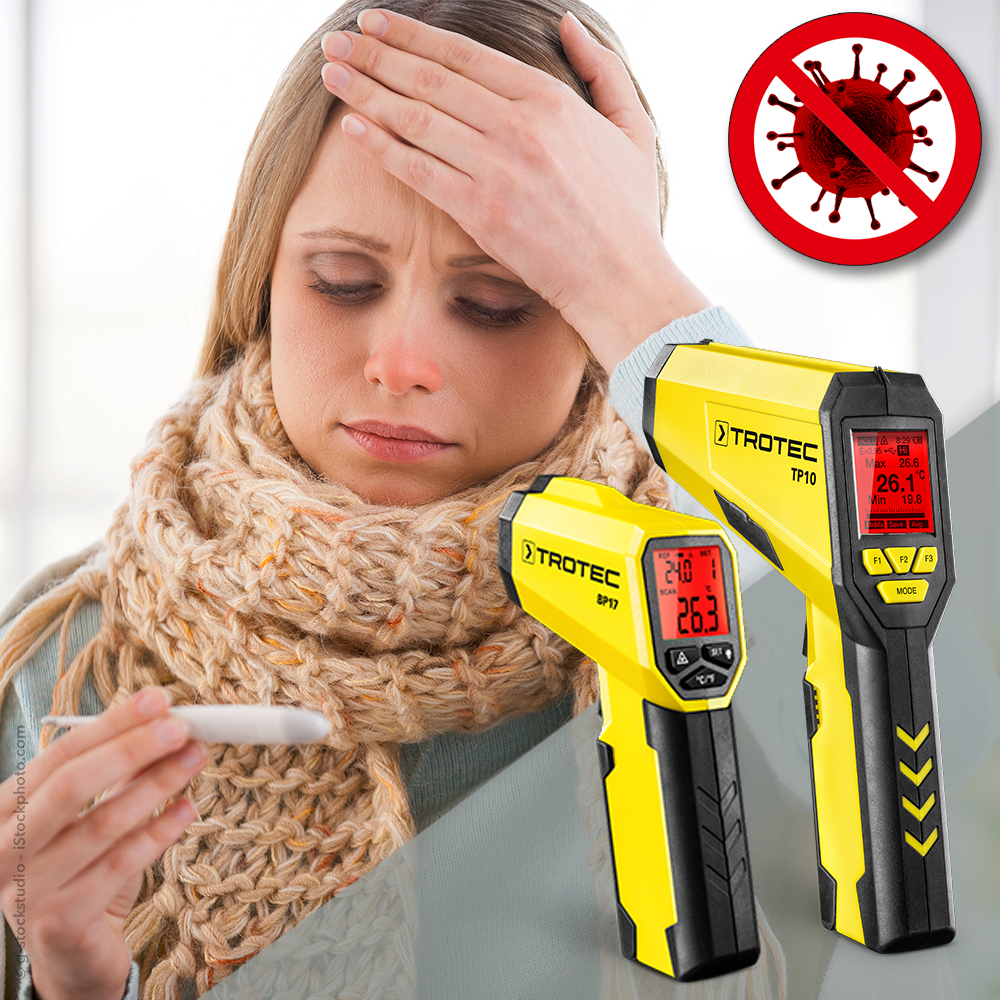 Industrial pyrometers are not approved for human diagnostic purposes, but in many cases they are suitable for practical pre-screening, e.g. in the case of epidemic disease distributions such as those currently prevalent in many countries owing to COVID-19
Industrial pyrometers are not approved for human diagnostic purposes, but in many cases they are suitable for practical pre-screening, e.g. in the case of epidemic disease distributions such as those currently prevalent in many countries owing to COVID-19
With the current enormous demand for clinical thermometers worldwide, some people are wondering why not simply use an infrared pyrometer as an alternative. Industrial pyrometers are not approved for human diagnostic purposes. Nevertheless, despite their somewhat lower accuracy, they are suitable for practical pre-screening in situations where elevated temperatures need to be detected in many people within a short time.
Infrared thermometers actually only show the temperature of the surface measured without corresponding correction factors, e.g. the forehead surface, but not the core body temperature, as is the case with professional thermometers offered especially for this purpose. These work with special calculation algorithms and in a limited temperature measuring range of slightly more than the maximum body temperature, which makes them unsuitable for use outside this measuring range (approx. 34 – 42 C).
Industrial thermometers usually have a much larger measuring range, which makes them a universally useful tool at work and in everyday life, even outside temperature screening on humans.
Non-contact measurement
Non-contact temperature screening is normally performed on the forehead. However, the forehead temperature is subject to fluctuations and depends, among other things, on the age, corpulence, environmental conditions and the current form of activity of the person being measured.
If, for example, you sweat after physical exertion, the evaporative cooling falsifies the result more than if you do not sweat. If you come from a cold environment into a warm one, your forehead will be cooler than normal for a while. This difference can be several degrees Celsius. The core body temperature, on the other hand, does not change but remains almost constant. And even light skin tone gives different results than dark skin tone etc.
Therefore, there is no simple conversion or factor with which the measured surface temperature, the so-called body shell temperature, can be easily converted to the body core temperature.
Nevertheless, even with industrial pyrometers, it is possible to obtain comprehensible results in relation to the body core temperature, taking into account a few points.
First Possibility Determination of the temperature difference
- Determine the actual core body temperature of different subjects of different ages using a suitable clinical thermometer and simultaneously take several forehead temperature measurements with your pyrometer on each of the subjects. The forehead should be dry. Make sure that the measuring distance to the forehead is not more than 5 to 10 cm. Never touch the forehead of the person to be measured directly to avoid cross-infections. Keep the pyrometer as still as possible during the measurement and wait until the measured value has settled.
- Calculate an average value from the measured values. For example, if the temperature measured by a clinical thermometer is 36.5 °C and the temperature measured by a pyrometer is 35.0 °C on average, it can be statistically assumed that the temperature measured by the pyrometer is on average about 1.5 °C below the core body temperature.
- If an alarm limit value can be set in the instrument, for example, assuming 38 °C as the reaction limit for an elevated temperature, the alarm in the instrument would have to be set to “36.5 °C”.
Second Possibility Determination of a corrective emissivity
- Determine the actual core body temperature of different subjects of different ages using a suitable clinical thermometer and simultaneously take several forehead temperature measurements with your pyrometer on each of the subjects. The forehead should be dry. Make sure that the measuring distance to the forehead is not more than 5 to 10 cm. Never touch the forehead of the person to be measured directly to avoid cross-infections. Keep the pyrometer as still as possible during the measurement and wait until the measured value has settled.
- Calculate an average value from the measured values. If your pyrometer has the possibility of changing the emissivity, adjust it until the pyrometer shows the same value as the thermometer reading when measuring the forehead temperature of each subject again.
- If an alarm limit value can be set in the device, and if, for example, 38 °C is assumed as the reaction limit for an increased core body temperature, set the limit value to “38 °C” accordingly.
Whichever of the above two possibilities you choose, please always keep in mind that each process is device-specific and cannot be transferred from one device to all devices, as each device has its own measuring errors and measuring uncertainties.
We would like to point out again that the pyrometer measurement may only be seen as an indicative screening and cannot replace a suitable temperature measurement, e.g. in the mouth, armpit or rectal measurements!
Questions about infrared thermometers?
Always at your side when it comes to answering questions about environmental measurement technology: Trotec Customer Service. The experts on the subject of temperature measurement in all areas are happy to help you on +2452-962 400 or by e-mail: info@trotec.de
We look forward to helping you further.

